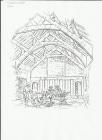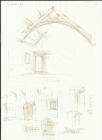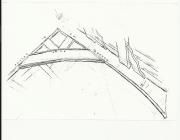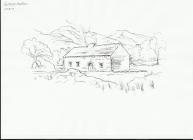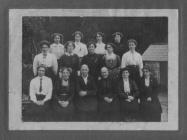Tŷ-Mawr, Nantmor – A House History
Items in this story:
Introduction
Tŷ-Mawr is a small, dry-stone house situated in Snowdonia on a level spot on the mountain slopes above Nantmor in the parish of Beddgelert. Although modest in appearance, the plan, features and the quality of its masonry and carpentry shows us that this was a small-scale hall-house of gentry-status. Tree-ring dating commissioned by the Dating Old Welsh Houses community project tells us the timbers used in its building date from 1529. Over the half millennium of its existence it has seen many changes in its occupants and use; as a high status hall, then a home for tenant farming families, later as a barn for hay and animals, and now restored to its former glory.
The historic features of Tŷ-Mawr
Tŷ-Mawr was tree-ring dated as part of the Dating Old Welsh Houses community project which aims to accurately date, and increase understanding of, Tudor and Jacobean houses in north-west Wales. Tŷ Mawr had been surveyed as far back as 1953 by the Royal Commission, because it was clear that the building had the features of an early hall-house: a hall of two bays with a central open truss, slots in the timbers suggesting a spere-truss (wooden aisle) at the entry, a dais partition with two entrances and a fine Tudor-arched doorway. The reconstruction drawing above shows what the interior of the hall-house may have looked like in the Tudor period.
Tree-ring dating told us that the principal rafters of the roof were felled in the summer of 1529, that the chimney and fireplace were added about a century later. The fireplace beam has a carved date of 1619 (or perhaps 1579, the numbers aren’t clear). This fits with the early 17th century pattern of a changeover from open halls with central hearths where the smoke escaped through open slated windows and vents in the roof, to fireplaces with chimneys. This radically altered the plan and use of the house allowing ceilings to be inserted and the hall space to be divided.
For more on hall-houses in Wales and their features, see Branas Ucha: chapter: Medieval hall-houses in Wales
Drawings by the artist Falcon Hildred below show some of the historical features at Tŷ-Mawr:
The photographs below show the the fine voussoir-headed entrance and interior door way at Tŷ-Mawr.
The owners and tenants of Tŷ Mawr
Although originally an important Tudor hall-house of gentry status, nothing is known of the family who had the house built and who lived there in the first 100 or so years.
Discovery of the early owners of TŷMawr is complicated by the fact that the property was called by different names at different times including ‘Tyddyn Mawr’, Tu Mawr, variations of ‘Gelli’r Cerddenu’ and Capel Anwes’ as well as TŷMawr.
The earliest known owner of TŷMawr was John Jones of Dol y Moch, Maentwrog. His attorney’s notebook records the following rent agreements for TŷMawr:
· 1640: ‘I have set unto John Thomas Griffiths my lands called Tŷ Mawr in Nantmor…for one year…for the rent of £3 6s 8d payable at Michaelmas’
· 1642: ‘Sett a lett…John Morris, Tythyn Mawr in Nantmor for the next yeare all ther rent of £3 payable Michaelmas’
· 1644: ‘Sett rent Richard ap John ap Powell tenement called Ty Mawr (Nantmor) £2 15s
· 1646: recd of John Morris of Tu Mawr in /nanmor two kine (cows) for five nobles (£1 13s 4d)
· 1644/45 John ap Howel for a tenement called Y Tythun Mawr
· 1645 of John Morris of Ty Mawr in Nanmor
In 1646, John Jones died. His son Richard Jones, who was married to Lowry ferch William, and presumably inherited the estate, but we can find no clear evidence of this.
Ownership becomes a bit clearer after TŷMawr became part of the nearby Hafod Gregog estate. The estate papers record TŷMawr from 1647, when Lowry ferch William Price entered into an agreement with Maurice Williams and his son William Williams of Hafod Garegog, by means of a grant to the uses of various properties, including Gelli’r Cerddenu. It may be that Lowry had inherited TŷMawr (and other properties) from her husband Richard Jones of Dol y Moch (they had had no children). Lowry remarried, and in a deed from1654, she and her new husband, Ellis Owen, sell Tŷ Mawr to Maurice Williams, Lewis Anwill of Dolefriog and Emmanuel ap Robert. Emmanuel ap Robert was a nephew of Lowry, being a son of Jane ferch William, one of her sisters. He was also the son of Robert ap Humphrey a descendent of Hywel ‘Coetmor’ who owned Gwydir and other large estates in the parish of Llanrwst.
In Emanuel’s will of 1689 he bequeaths his estate to his nephew Ellis Jones, who in turn bequeaths it to his son, John Ellis.
A deed of 1716 releases ‘Gelli y Garddinen otherwise Ty Mawr’ and other lands in the township of Nanmor to Maurice Williams of Glascoed, gent. [This deed refers to Lowry ferch William Price, widow, afterwards wife of Owen Ellis and Ellis Jones, nephew of Emanuel and father of John Ellis and Owen Ellis, all former owners of the property].
As part of the Hafod Garegog estate, Tŷ Mawr, along with its other properties, changed ownership throughout the 18th century as deaths and marriages put it into different hands. Finally, in 1811, the estate passed to the Priestley family of Leeds. Throughout this period, Tŷ Mawr was lived in by tenants who farmed the land, often supplementing their income with other occupations such as labouring and coopering.
The Williams and Jones families
In the early 1800s it is believed that Tŷ Mawr became a meeting place for Wesleyans, which may explain the use of the later name for Tŷ Mawr of ‘Capel Anwes’ or chapel of ease. Alternatively, the ornate roof may have encouraged the belief that Tŷ Mawr had been a chapel. The use of biblical names starts to appear in families from this period, a sign of the strength of the nonconformist beliefs in this area.
From about this period the tenants of were called Williams and this family continued to rent and farm Tŷ Mawr and it’s 40 or so acres until the 1920s. Peniel Calvinist Methodist Chapel in the village of Nantmor, was built in 1829, and it is known that the Williams family attended this chapel.
Moses Williams was born in about 1829. In the 1841 census he is aged 12 and living with his family in a new house, also called Tŷ Mawr. This is a small cottage which was built in the 1820s next to the old hall-house of Tŷ Mawr which is now occupied by two families, both called Jones who were related by marriage to the Williams family. The first family were Richard and Ann Jones and their family of five children. Richard and his son Thomas are listed as copper miners, and may have worked in the nearby Cwm Bychan copper mine which prospered at this time. The second Jones family living in Tŷ Mawr were Hugh and Margaret Jones and their family of four children. Hugh was a stone mason in a nearby quarry and with his family emigrated to America in 1849. People from North Wales had been emigrating for some years to particular areas in America. Hugh and his family travelled by steerage class to Collinsville in upstate New York where a Welsh settlement was well established there.
(Photos: Samuel Milton Jones and his gravestone in Toledo, shown by kind permission of Mark A. Pawelczak, Ohio historian, Toledo district).
Their son Samuel ‘Golden Rule’ Jones (shown above with his gravestone at Toledo) became a prosperous manufacturer, human rights advocate and the mayor of Toledo. In his biography he wrote that his father Hugh had heard: ‘stories of prosperity…and was stirred with ambition to try to better his hard lot’, he also wrote that his parents were: ‘really – not merely professionally – religious’. This may have been the result of the Great Methodist Revival which started in the nearby town of Beddgelert in 1817, the resulting religious fervour sweeping across the area in the following years. Samuel returning on a visit to Tŷ Mawr in 1896 took a photograph of the old house and its occupants.
It seems that the old Tŷ Mawr was occupied by a new family shortly after the Jones family left for America as Morris and Jane Roberts and their family of four children is listed in the 1851 and 1861 censuses. They were the last family to live in the old house, moving to Ferlas, Nantmor, in the 1860s.
When the old house was abandoned as a home, it become a barn, the northern half of it belonging to the neighbouring farm of Carneddi with a door to the north, and the southern half of it belonging to Tŷ Mawr. Hay, cattle and horses were now sheltered there during the hard Snowdonian winters.
The Williams family continued to occupy the new cottage also called Tŷ Mawr. The 1881 Census lists as occupants, William Williams, his wife Ann, whose family came from Carneddi next door, and his children including a son, Moses aged 27 and listed as a quarryman. William Williams died the same year aged 66 and his son Moses took over the farm, married Jane? and had William, Griffith and Annie who all attended Nantmor school and Capel Peniel. Moses supplemented the farm’s income by trading as a butcher.
The Land Valuation Survey of 1910 lists Tŷ Mawr as having 48 acres and 1 rood. The owner was still the Priestley family and the tenant was Moses Williams. The land belonging to Tŷ Mawr was mainly mountainous with small stone-walled fields close to the house kept for hay to feed the animals in the winter. The livestock would have been mountain sheep and a couple of cows for milk, butter and cheese.
The 1911 census lists Moses as 57 years old, living with his wife Jane, sons William and Griffith (both in their 20s and working on the farm) and daughter, Anne, aged 17. The photograph above, taken at Capel Peniel in 1913, shows an Anne WIlliams, Tŷ Mawr (back row, second left) who looks to be the right age to be this Anne.
In 1920 the Priestley family put the Hafod Garegog estate up for sale. Richard Griffith was able to buy his farm, Carneddi with the half of Tŷ Mawr barn. Moses Williams left soon after the sale when a Mr Lloyd bought the property, but he continued his butchering business in Beddgelert. The Lloyd family lived in Tŷ Mawr cottage, and then in the 1930s a John Griffiths and his family moved in.
Carneddi and the poet ‘Carneddog'
Richard Griffith, the renowned poet known by the bardic name of ‘Carneddog’ lived at Carneddi, the neighbouring farm which held half of the old Tŷ Mawr, now a barn, and was also part of the Hafod Garegog estate. He is said to have found a book in Latin by Erasmus in a hole in one of the walls.
In 1945, Richard Griffith and his wife Catrin were compelled to leave Carneddi when they were in their nineties, after their son was drowned in a nearby lake. Generations of the Griffith family had lived and farmed there. A moving set of photographs by Geoff Charles shows the old couple on their departure, the one above shows conveys something of the feelings of the couple and of the expansive mountainous landscape of the area surrounding Tŷ Mawr and Carneddi.
Mr Wilfred Dunn of Nottingham brought Carneddi from Richard Griffiths as well as Tŷ Mawr and other properties in the area for use as holiday cottages.
The Ruck family and the ‘Place of Stones’
(Photo: Ruth Janette Ruck at home in Carneddi, 15th June, 1961, by Geoff Charles from NLW collection).
The Ruck family bought Carneddi from Mr Dunn and have been farming there ever since. They rented Tŷ Mawr cottage in 1955, and in 1968, bought the land and the other half of the old Tŷ Mawr barn. Their story is told in the trilogy of books written in the 1960s by Ruth Janette Ruck. As well as chronicling hill farming life and her efforts to make the farm profitable, she describes the old Tŷ Mawr, or Capel Anwes as ‘the best building on the farm’ having:
‘… all the features of a medieval hall. There were two arched doorways opposite each other. In the old days a fire had burned on a central hearth and smoke found its way out through a hole in the roof. There had been rooms for sleeping at each end of the building, screened by wattle wall. In the 16th century, a huge chimney –breast and oak-beamed fireplace had been built on the site of the central hearth, dividing the hall in two, and oak panelling of the same date with two arched doorways had screened a further room. In later years when the ancient building had become a barn, half of it had belonged to Carneddi with a door to the north, while the southern half of it had belonged to Tŷ Mawr. Loads of summer hay and cattle and horses were sheltered there through long winters past’. (Hill Farm Story, 1966, pp92-94).
In the 1980s the old Tŷ Mawr was sensitively restored by the architect Adam Voelker. The 16th century stone-walled building is still in use into the 21st century.
Resources:
Research notes by Margaret Dunn, director of the DatingOldWelsh Houses
Beddgelert Its Facts, Fairies & Folklore, D E Jenkins, 1899
RCAHMW - Caernarvonshire Inventory II, Caernarvonshire Parish Files
Houses of the Welsh Countryside, Peter Smith, 1988
University of Wales Bangor, Archives and Special Collections
Dolfriog estate papers at the National Library of Wales
Achau rhai o deuloedd hen Siroedd Caernarfon, Meirionnydd a Threfaldwyn, T C Griffith, 2003
Memorial inscriptions of the Church of Saint Mary, Beddgelert, Gwynedd Family History Society
Gelli’r Ynn, Ellen Jones, 2008
Place of Stones, Ruth Janette Ruck, 1961
Hill Farm Story, Ruth Janette Ruck, 1966
Casgliad Geoff Charles Collection, National Library of Wales
The members of Capel Peniel Nantmor for the photograph of the Temperance Society, Capel Peniel

